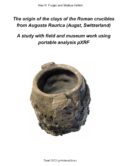The origin of the clays of the Roman crucibles from Augusta Raurica (Augst, Switzerland). A study with field and museum work using portable analysis pXRF
by Alex Furger and Markus Helfert – an open access publication promoted by LIBRUM P&E
The project involved analysing 893 Roman crucibles for non-ferrous alloys from Augusta Raurica (Switzerland) using laboratory and portable devices. This resulted in the identification of 5 clay groups, which were compared to 60 reference groups from the surrounding area. Most of the crucible clays came from 2 clay deposits, one of which was located nearby, while the other was situated 50 km away in the Jura region.
The metals casted show a large variety of bronze- and brass-alloys, due to scrap-recycling. Brass making by cementation could be proved in many crucibles.
The crucibles were composed of two layers: a wheel made core of fired ceramic and a lutum layer made of local materials applied to the exterior (and sometimes a thin engobe applied to the interior). In the casting process, the mechanically stabilising and insulating lutum swelled up and vitrified considerably.
Available open-access only.
Details
| Autor/en | Alex Furger, Markus Helfert |
| Format: | A4 |
| Verlagsort | Basel |
| Jahr: | 2023 |
| Sprache/n | English |
| Preis (CHF) | free CHF |
| Preis (EUR) | free EUR |
| DOI: | 10.19218/3906897929 |


